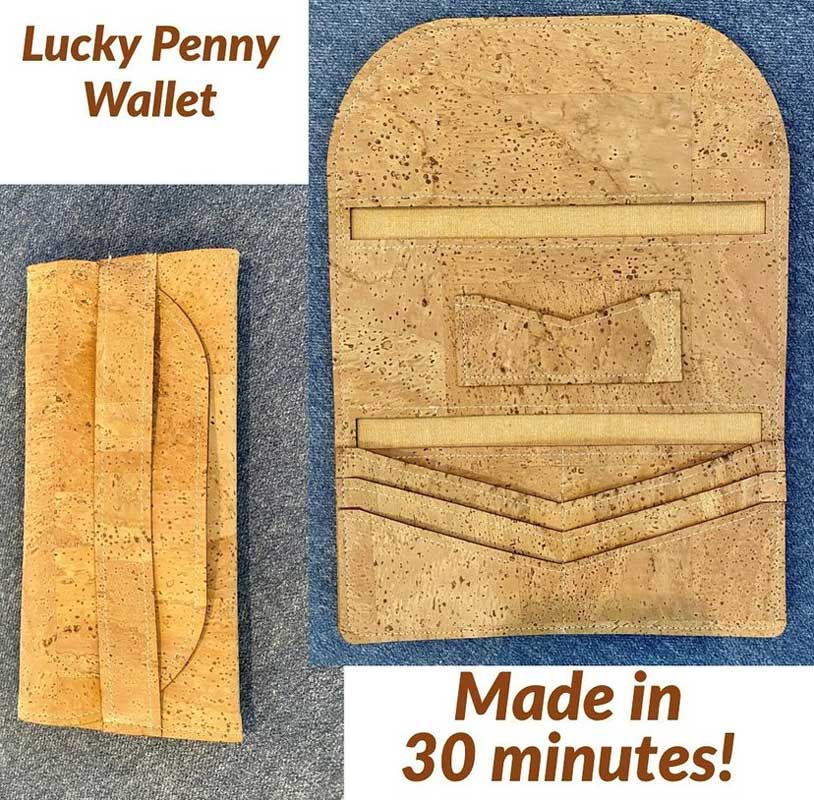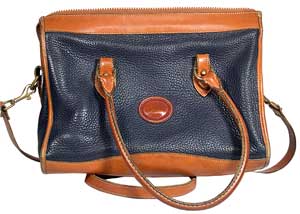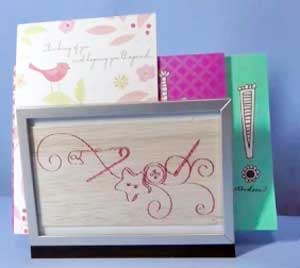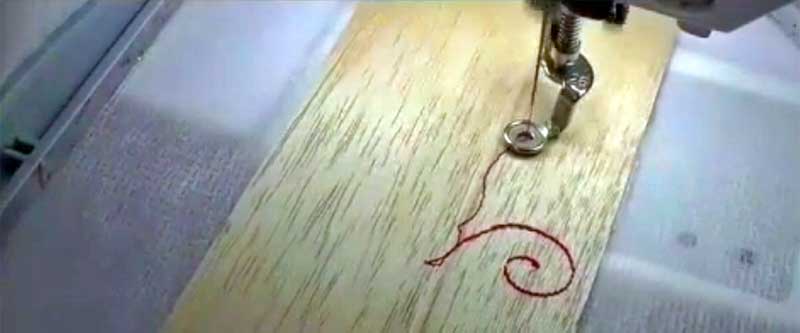Once you venture into the world of sewing and get comfortable with some of the basics, it is amazing to discover, like the popular Dr. Seuss book says – “Oh the places you will go!” Many an adventurous sewist has explored sewing on what some may consider unconventional things. As an example, take a look at the interview we did with Olivia Mears. She has used many unconventional items, like Taco Bell sauce packets and gift wrap, in her sewing. But there are certainly fewer unconventional items to sew with that will still feed your adventurous spirit. In this article, we will look at cork. leather, and wood.

Cork
 Cork is a sustainable, natural product that is harvested from Cork Oak trees. When the trees are 25 years old (they can live up to 200 years!), the bark can be harvested and the tree regenerates until the next harvest in about 9 years. The harvested cork is processed by drying, boiling then gluing it to a backing before rolling it for distribution. Cork can be used for all sorts of projects, like handbags, pouches, and wallets. It holds its shape and is quite durable. And it’s surprisingly easy to sew on your home sewing machine with just a few helpful tips.
Cork is a sustainable, natural product that is harvested from Cork Oak trees. When the trees are 25 years old (they can live up to 200 years!), the bark can be harvested and the tree regenerates until the next harvest in about 9 years. The harvested cork is processed by drying, boiling then gluing it to a backing before rolling it for distribution. Cork can be used for all sorts of projects, like handbags, pouches, and wallets. It holds its shape and is quite durable. And it’s surprisingly easy to sew on your home sewing machine with just a few helpful tips.
- Scissors or a rotary cutter both cut cork easily.
- Use a polyester thread.
- Use a size 80-90 universal or embroidery needle. If the layers are thick, try an 80-90 leather or denim needle.
- Use a Teflon or a walking foot to help move the cork smoothly through the machine.
- It is best to test sew with a ‘fabric sandwich’ before you start. Make your fabric sandwich with the same layers you will sew in your project. The best time to make any needle or tension adjustments is before you get to your actual project.
- Lengthen your stitch length to about 3–4 to avoid perforating the cork too much. And topstitching should be lengthened even more to about 5-5.50.
- To prevent holes in your cork, it is best to use sewing clips. Pins can be used inside the seam allowance, but clips usually work much better.
- Double-sided tape or glue is helpful to hold small pieces in place. Just avoid sewing through the tape or it may make your needle sticky and may cause skipped stitches.
- If you do have to unpick, try to re-sew into the same holes.
Jessica from Sallie Tomato made this 6-minute video with some great info about cork and how to get started with it.
Leather
 Leather, made from animal hides or skins, comes from various animal hides, such as cows, crocodiles, pigs, even stingrays. Leather is durable, wrinkle-resistant, and will take on a different look/feel based on the type of animal, grade, and treatment. Sewing with leather may seem daunting, but with only a few tips, you can successfully make everything from bags, garments, and home dec.
Leather, made from animal hides or skins, comes from various animal hides, such as cows, crocodiles, pigs, even stingrays. Leather is durable, wrinkle-resistant, and will take on a different look/feel based on the type of animal, grade, and treatment. Sewing with leather may seem daunting, but with only a few tips, you can successfully make everything from bags, garments, and home dec.
Here are a few to get you started.
- Use a leather needle. The heavier the leather, the heavier the needle.
- Sew with 100% polyester thread. Over time, leather eats natural fiber threads like cotton.
- Home sewing machines can sew up to about 2 oz leather. Heavier leather may be too dense for your machine.
- Use a Teflon foot, roller foot or, walking foot to sew more smoothly.
- As with cork, lengthen your stitches to about 3–4 to avoid perforating the leather too much. And topstitching should be lengthened even more to about 5-5.50.
- Leather has no grain! Layout your pattern any way you wish. But watch for blemishes and ripples and avoid using them in a visible area.
- Always use a rotary cutter or Exacto knife to cut leather. Scissors can mar the cut edge.
- Trace the pattern pieces on the wrong side of the leather then cut out on the traced lines. Since you can’t pin the piece down, it is difficult to cut around the piece itself.
- Remember that dyed leather will bleed onto fabric. If you are making a garment, this must be considered. According to Peggy Sagers, you can wash your leather to remove some of the dye and reduce or eliminate the bleed when cleaning later. If making an all-leather garment (like a vest or jacket), you will want to line it to prevent color bleed on whatever you wear under the leather garment.

For those of you who love to do machine embroidery, don’t skip leather as one of your options. Watch this 2015 video in the Members Only section for a simple starter project with lots of helpful tips. (You must be logged into ASG account before clicking the link so you go straight into the video).
Wood
 If the idea of sewing with leather didn’t scare you off, you may be adventurous enough to try sewing on wood. No, you probably won’t be making a dress or a pair of pants from wood, but it can be used to make interesting accents, ornaments, box tops, home decor pieces, etc. And it certainly will be intriguing to show off at your next Neighborhood Group show-and-tell!
If the idea of sewing with leather didn’t scare you off, you may be adventurous enough to try sewing on wood. No, you probably won’t be making a dress or a pair of pants from wood, but it can be used to make interesting accents, ornaments, box tops, home decor pieces, etc. And it certainly will be intriguing to show off at your next Neighborhood Group show-and-tell!
To help you venture “into the woods,” you need a few tips.
- Choose a very thin wood such as 1/32″ veneer. Balsa is an ideal choice. You can usually find it at a hobby store where they sell model airplane-making supplies. You may be able to stitch on wood up to 1/8″ thick and in some instances soft woods that are 1/4″ thick, depending on the stitch.
- Use an adhesive stabilizer on the back to help prevent splitting. If both sides will show, use a removable stabilizer, otherwise just leave the extra layer in place.
- For thinner woods, use a small needle (75/11) to avoid leaving big holes and splintered areas around the stitches. Use a larger needle for thicker wood.
- Use longer than normal stitches to avoid perforations and subsequent breaking.
- If using a decorative stitch, select stitches that don’t re-enter the same hole during sewing. If you can adjust the speed of your machine, change it to slower than normal to avoid heat build-up at the needle.
- Always test-stitch on wood scraps before starting your project. Just like in fabric, the wood grain direction can influence the appearance and stability of your project.
You can also embroider on wood with openwork designs. Simply secure the wood in the hoop with an adhesive stabilizer or temporary spray adhesive. Use a hoop larger than the wood section to avoid bending it and to keep it flat while stitching. To see an example of embroidery on wood, watch this presentation published in 2015 in our Members Only area. (You must be logged into ASG account before clicking the link so you go straight into the video).

So, now it’s your turn!
Venture out into a new area and try one of these materials in your next project. We would love to see your results! Share them by emailing them to me at sbelson@asg.org. If we get enough input, maybe we can do a follow-up story of all “the places you will go!”
~Sheryl Belson





